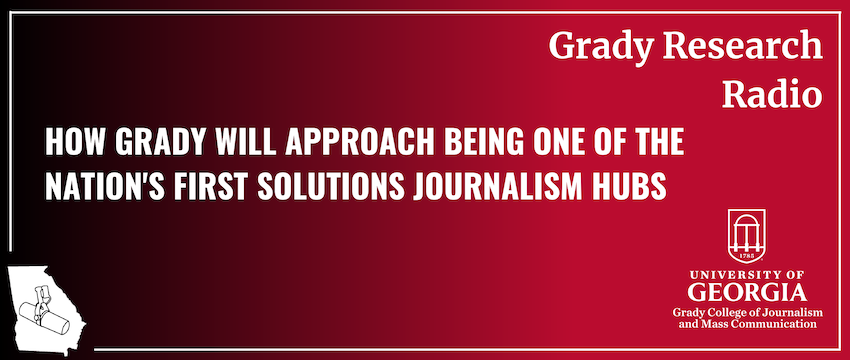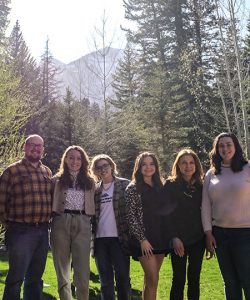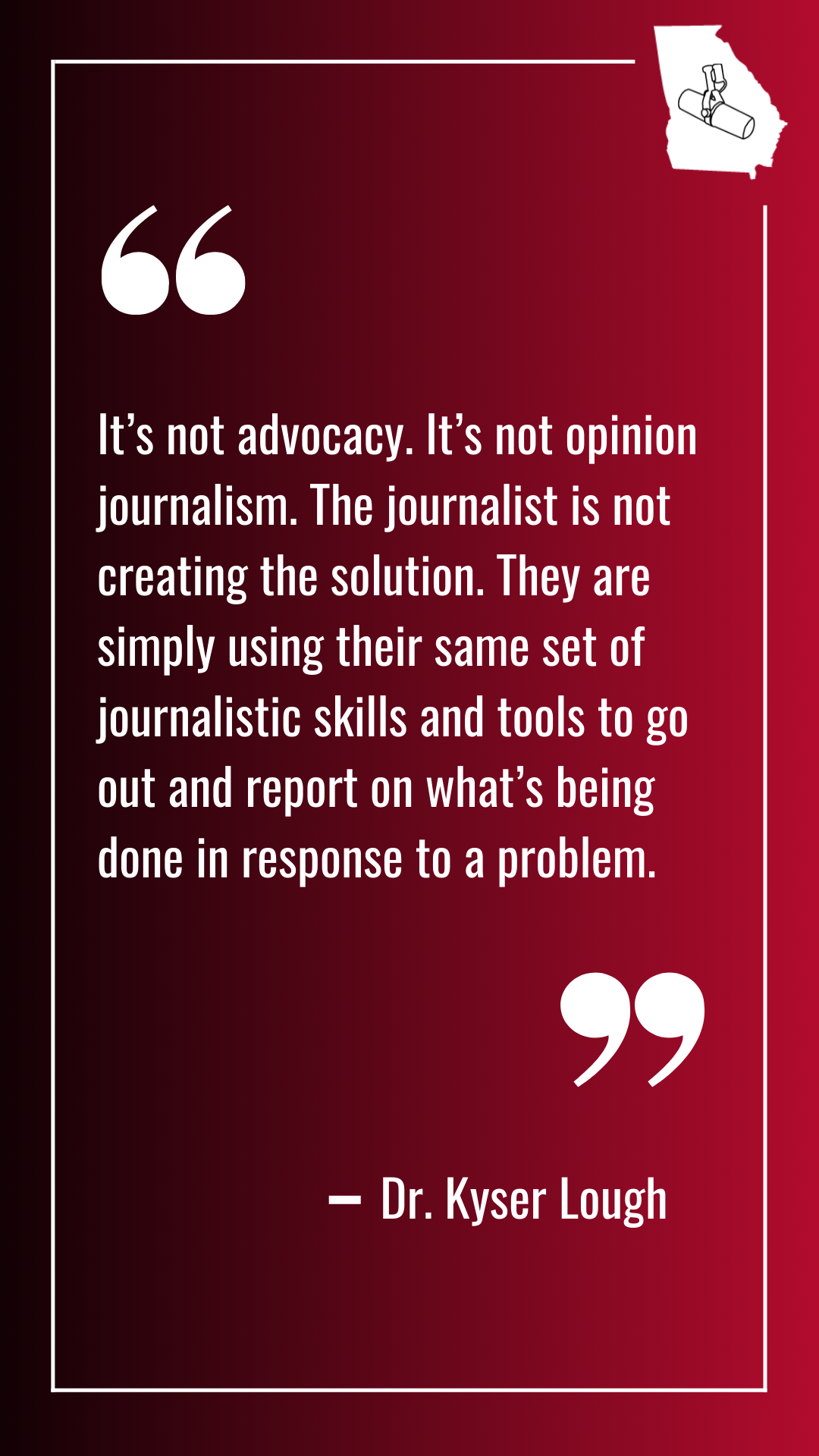Podcast: How Grady College will approach being one of nation’s first solutions journalism hubs

Podcast: How Grady College will approach being one of nation’s first solutions journalism hubs
Apple Podcasts/Spotify/Stitcher
At the beginning of August, the Solutions Journalism Network named Grady College one of the nation’s first solutions journalism hubs, a designation given to only three other colleges in the United States. In this role, Grady College’s Department of Journalism will be tasked with continuing to serve as an incubator for creativity, innovation and research in solutions journalism and function as a resource for students and professionals in the region who are interested in the field.
To further unpack what this designation means, solutions journalism experts Dr. Amanda Bright, director of the Cox Institute Journalism Innovation Lab, Dr. Kyser Lough, an assistant professor in Journalism, and Ralitsa Vassileva, a lecturer in Journalism, were recently interviewed as a part of Grady College’s Grady Research Radio podcast.
Below is a transcription of the podcast, edited for clarity and brevity.
Grady College: What is solutions journalism, and why is there a need for it?
Kyser Lough: Well, solutions journalism is a method of reporting where the reporter goes out and, instead of just reporting on the problems communities are facing, they also look for what people are doing about it.
It’s not advocacy. It’s not opinion journalism. The journalist is not creating the solution. They are simply using their same set of journalistic skills and tools to go out and report on what’s being done in response to a problem.
It was kind of born out of this idea that we sometimes focus too much on problems. I mean, it’s good. We have to uncover and thoroughly define the problems a community is facing. That’s a very important purpose of journalism. But if we only focus on that, then all we’re showing our readers is that, you know, it’s just doom and gloom all the time, and we know that’s not true. We know there are people out there trying to address these problems. So why aren’t we reporting on that, too?
A lot of people just call it just good journalism. I think putting a name on it was important to help really define what it is, but at the end of the day, it’s something a lot of journalists have been doing. It’s just that we feel a lot of folks haven’t been doing it enough.
Grady College: Amanda Bright explained that solutions journalism entered the curricula at the college roughly four years ago as a very small piece of the capstone undergraduate reporting classes in journalism. Since then, though, solutions journalism has become a part of every undergraduate capstone class. At this point, every journalism student at Grady College leaves with knowledge in some practical application of solutions journalism.
Many student-made solutions journalism pieces are available online at Gradynewsource.uga.edu. While looking through some of those pieces, I noticed that they are far from your standard text-based news stories. The students who make the pieces often weave in both audio and visual components. So, I asked Ralitsa Vassileva about teaching multimedia solutions journalism storytelling in her classes.

Ralitsa Vassileva: In my sustainability multiplatform class, I required students to use four different media platforms to tell (a solutions journalism story) besides text. It could be video. It could be audio. It could be graphics. Whatever the story requires. While for my broadcast students, I challenge them at the end of the semester to produce short videos of a solution story, again, sticking to those principles of solutions journalism for rigorous reporting, which is not easy in a minute and a half to two minutes. But with the growing importance of short videos, this is a very effective way to reach audiences.
Grady College: What does this designation, being named a solutions journalism hub, mean?
Amanda Bright: You know, we’re still trying to figure some of that out. Our four hub schools, we’ve had lots of conversations already about what that’s going to look like on each of our university campuses and what it’s gonna look like in our regions, because we’re really representing the Southeast.
I think a lot of that is coming to fruition as it develops, but our goal is to be a place of teaching, training, learning and resource for our geographic area. We have several faculty members who are passionate about this. We have been practicing it for a while now, so we’ve learned some things.
We want to bring in students who want to do this kind of work, researchers who want to do this kind of work, and industry partners and news organizations that want to do this and try to marshal those resources to grow what solutions journalism is and what it means for communities.
Grady College: What does this designation mean in terms of advancing solutions journalism research? What opportunities are there for collaboration with students and professional journalists in the region who are interested in this research?
Kyser Lough: For me, the designation means a lot when it comes to research, because it further legitimizes what we’re doing here.
It can be difficult, as a scholar, to reach out to journalists and ask them, “Hey, can I interview you and (confidentially) ask you, you know, some of these complicated questions about the work you do.” Even just getting a response can be difficult.
Or, if we want to partner with a newsroom, sometimes it’s not enough just to be somebody at the University of Georgia. They’re skeptical about what participating in this research means. Being able to come at it from, you know, “We’re from the solutions journalism hub. This is what we study. This is what we do,” I think that’s going to add a lot of oomf in our research and any grant applications that we’re doing. It’s important just in getting the visibility out there that this is a legitimate site of study. We’re a place where people who have questions can come to. If they are an editor of a newsroom and they want to know if this is having any impact, they can come to us and we can look at surveys, focus groups and other ways to assess what’s going on in their newsroom when it comes to solutions journalism and the audience.
I have several studies that I’m currently working on that I’m always excited to have other people come on board with. I’m also excited to have people come pitch an idea, and we’ll talk about the potential.
Students who are interested can come to our Master’s program or our PhD program, and they can incorporate that into their studies. We can talk about independent study. We could also work that into their actual program of work for their thesis or dissertation.
There are so many different ways you can take this and apply it, especially to different reporting topics, which is another thing that we’ve been hoping to expand on in the research. How does this play out in health reporting? How does this play out in education reporting, where you’re constantly hearing that either a school has super high scores or super low scores. We never really hear about what schools are doing to try and address those issues.
There’s lots of different topics we can apply it to. Somebody doesn’t have to come here and be a solutions scholar. They can come here being very interested in political coverage. As part of that, we look at solutions journalism and how that can apply to that specific topic.
Grady College: The experts included in this interview want to hear from you, the current and future students, educators and industry professionals in the region. Their contact information is listed below.
Amanda Bright: Amanda.Bright@uga.edu
Kyser Lough: KyserL@uga.edu
Ralitsa Vassileva: Ralitsa.Vassileva@uga.edu
